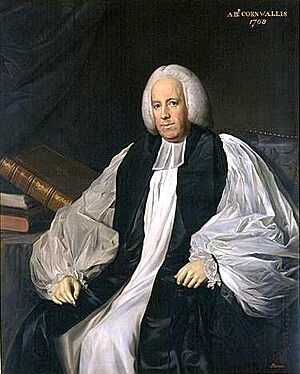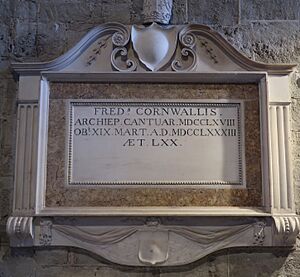Frederick Cornwallis facts for kids
Quick facts for kids The Most Reverend and Right Honourable Frederick Cornwallis |
|
|---|---|
| Archbishop of Canterbury | |

Portrait by Nathaniel Dance-Holland
|
|
| Church | Church of England |
| Diocese | Canterbury |
| In Office | 1768–1783 |
| Predecessor | Thomas Secker |
| Successor | John Moore |
| Orders | |
| Consecration | 19 February 1750 by Thomas Herring |
| Personal details | |
| Born | 5 March 1713 London, England |
| Died | 19 March 1783 (aged 70) Lambeth, London, England |
| Buried | Church of St Mary-at-Lambeth |
| Nationality | English |
| Denomination | Anglican |
| Previous post | Bishop of Lichfield (1750–1768) |
| Alma mater | Christ's College, Cambridge |
Frederick Cornwallis (born 5 March 1713 – died 19 March 1783) was an important British church leader. He served as the Archbishop of Canterbury, which is the main leader of the Church of England. He came from a noble family and had a long career in the church.
Early Life and Education
Frederick Cornwallis was born in London, England. He was the seventh son in his family. His twin brother, Edward Cornwallis, was born just before him. Frederick went to Eton College, a famous school. Later, he studied at Christ's College, Cambridge University.
In 1742, he became a priest. This meant he could lead church services. By 1748, he earned a special degree called a Doctor of Divinity.
Career in the Church
Frederick Cornwallis moved up quickly in the Church of England. This was partly because his family was very well-known and powerful. In 1746, he became a chaplain to King George II. A chaplain is a priest who serves a royal family or an organization. He also became a canon at Windsor. A canon is a type of priest who works at a cathedral.
In 1750, he became a canon at St Paul's Cathedral in London. Later that year, he became the Bishop of Lichfield and Coventry. A bishop is a senior leader in the church. He got this position with the help of the Duke of Newcastle. The Duke was a very important government official at the time. Cornwallis also served as the Dean of Windsor from 1765 to 1768. He was also the Dean of St Paul's from 1766 to 1768.
When the previous Archbishop, Thomas Secker, died in 1768, Frederick Cornwallis became the new Archbishop of Canterbury. This happened because he was friends with the prime minister, the Duke of Grafton. As Archbishop, he was known for being friendly and easy to get along with. He was well-liked by many people.
He supported the government led by Lord North. He also helped Anglican priests who lost their churches during the American Revolution. This happened in the Thirteen Colonies, which later became the United States. Frederick Cornwallis was buried at St. Mary's Church, Lambeth.
People generally remember Cornwallis as a good manager. However, they also thought he wasn't a very inspiring leader for the church.
Family Connections
Frederick Cornwallis had a twin brother named Edward Cornwallis. Edward chose a different path and became a general in the British Army. He served as a military governor in colonies twice. He also founded the city of Halifax, Nova Scotia, in Canada in 1749.
Frederick's nephew was Charles Cornwallis, 1st Marquess Cornwallis. This nephew was a British general during the American Revolution. He is famous for surrendering his forces at Yorktown, Virginia. Later, he became the Governor-General of India, a very important role.
Discovery of a Coffin
In 2016, something interesting was found at the Garden Museum. This museum is located in the old church of St Mary-at-Lambeth. During renovations, workers found 30 lead coffins under the church floor. One of these coffins had a red and gold mitre on top. A mitre is a special hat worn by bishops and archbishops.
Two archbishops were identified by nameplates on their coffins. Church records show that three more archbishops, including Frederick Cornwallis, are likely buried there.


